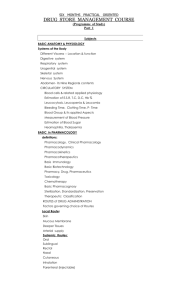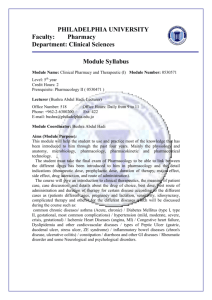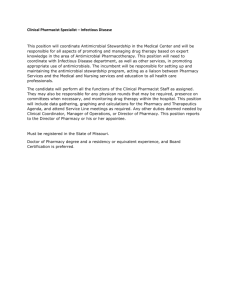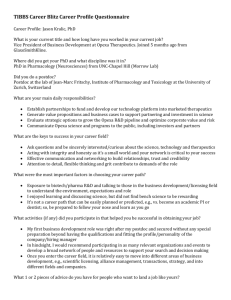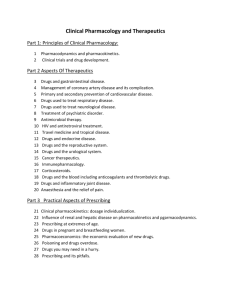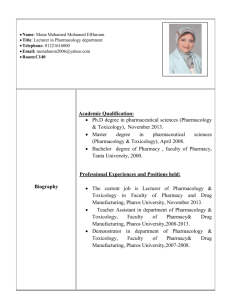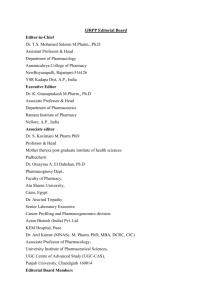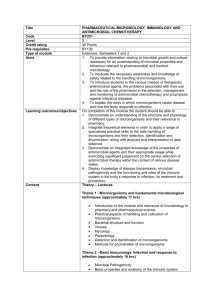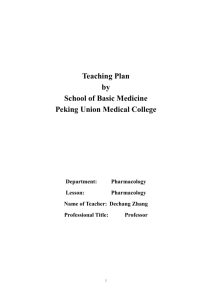module details
advertisement
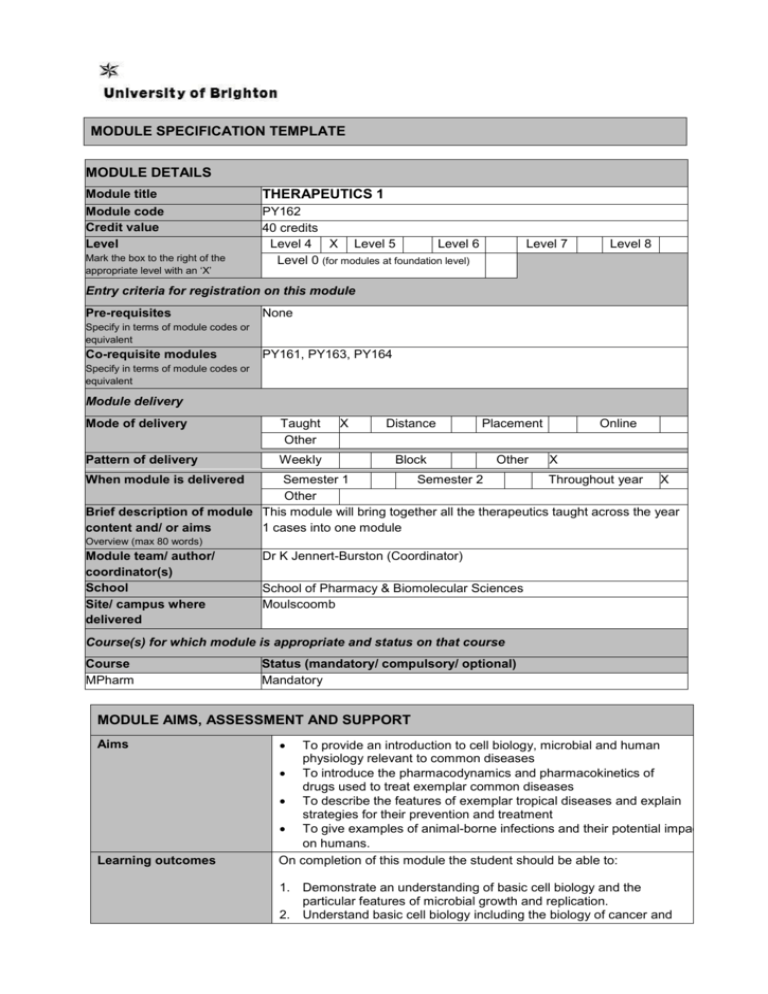
MODULE SPECIFICATION TEMPLATE MODULE DETAILS Module title THERAPEUTICS 1 Module code Credit value Level PY162 40 credits Level 4 X Level 5 Level 6 Level 0 (for modules at foundation level) Mark the box to the right of the appropriate level with an ‘X’ Level 7 Level 8 Entry criteria for registration on this module Pre-requisites None Specify in terms of module codes or equivalent Co-requisite modules PY161, PY163, PY164 Specify in terms of module codes or equivalent Module delivery Mode of delivery Taught Other Pattern of delivery Weekly X Distance Placement Block Other Online X When module is delivered Semester 1 Semester 2 Throughout year X Other Brief description of module This module will bring together all the therapeutics taught across the year content and/ or aims 1 cases into one module Overview (max 80 words) Module team/ author/ coordinator(s) School Site/ campus where delivered Dr K Jennert-Burston (Coordinator) School of Pharmacy & Biomolecular Sciences Moulscoomb Course(s) for which module is appropriate and status on that course Course MPharm Status (mandatory/ compulsory/ optional) Mandatory MODULE AIMS, ASSESSMENT AND SUPPORT Aims Learning outcomes To provide an introduction to cell biology, microbial and human physiology relevant to common diseases To introduce the pharmacodynamics and pharmacokinetics of drugs used to treat exemplar common diseases To describe the features of exemplar tropical diseases and explain strategies for their prevention and treatment To give examples of animal-borne infections and their potential impact on humans. On completion of this module the student should be able to: 1. Demonstrate an understanding of basic cell biology and the particular features of microbial growth and replication. 2. Understand basic cell biology including the biology of cancer and Content the mechanism of action of selected anti-cancer drugs. 3. Demonstrate understanding of the basic concepts of the mechanisms of drug action. 4. Describe ways in which the autonomic nervous system can be modulated by drugs. 5. Demonstrate a basic knowledge of the physiology and pathology of the gastrointestinal tract and the airways. 6. Explain the pathophysiology of anaemias and their treatments 7. Display a knowledge of common conditions of the skin, eyes, ears, and mouth and their treatment in a community pharmacy setting. 8. Understand the treatment of pain including evidence-based medicine. 9. Demonstrate a knowledge of a range of tropical diseases, their prevention and treatment. 10. Appreciate the features of sexually transmitted infections. 11. Demonstrate awareness of the zoonotic risk to public health and the measures to prevent transmission of disease. The material pertaining to these learning outcomes will be delivered in an integrated manner by presentation of a range of illustrative case-studies. For example: Lectures Introduction to life forms, cellular structures and micro-organisms. The distinctions between the various groups microorganism, their classification and their pathogenic potential: the concept of harmless and hazardous strains. The body’s defences against infection and body sites vulnerable to infection. Introduction to antimicrobial drugs: the distinction between antibiotics, antiseptics and other classes of biocides. Introduction to the concept of selective toxicity. Targets for antimicrobial drug action. Some principles of antimicrobial drug therapy: criteria to be satisfied in order to achieve successful treatment of an infection. Antibiotic susceptibility and resistance, and its measurement. Antibiotics available for the treatment of ophthalmic infections. The maintenance of sterility of ophthalmic products during use; sterile and non-sterile products and factors predisposing to microbial spoilage of medicines. Preservative toxicity. (Conjunctivitis Case) Introduction to cancer (incidence, diagnosis, types of cancer) The eukaryotic cell, hallmarks of cancer cells. Cancer and gene mutations (including genes, gene expression, DNA replication and repair). The cellular effect of benzpyrene mutations (including introduction to cell cycle and signalling). Mechanisms of anti-cancer therapies. (Lung Cancer Case) Cell membrane structure and function, resting membrane potential, nerve action potential, sensory receptors. Drug-receptor interactions. Gate Theory and the mechanisms of action of analgesics. (Pain Case) Thrush, chlamydia, cystitis (gonorrhoea & syphilis) & treatment . Anaemia: formation and breakdown of red blood cells. Intake and transport of iron around the body, transferrin, ferritin, B12 and folic acid. (Sexual Health Case) Neuronal and hormonal regulation of the GI tract including role of autonomic and sympathetic nervous system, role of endocrine and paracrine hormones. The physiology of digestion and absorption including digestion of carbohydrates, proteins, lipids, vitamins. The three phases of digestion (cephalic, gastric, intestinal). Proteins, carbohydrates, fats and glycolysis / Krebs cycle. The role of bacteria in the GI tract including role of commensal bacteria. Probiotics and nutrition including background on the use of probiotics, physiological actions, controversies. (Indigestion Case) Causative agents of skin infections and their treatment. MRSA. (Skin case) Anatomy of the airways; microbial transmission and infection (to include bacterial vs viral); basic introduction to histamine and its pharmacology. (Cold Case) Malaria – anti-malarials: mode of action, prophylaxis. (Holiday Health) Zoonotic risk – eg Weil’s disease (leptospirosis), deer ticks / lyme disease, hookworms, roundworms, tapeworms, toxoplasmosis, psittacosis, cat scratch fever (bartonellosis), bovine spongiform encephalopathy (BSE). (Veterinary Medicine) Indicative laboratory sessions 1. Sources of microbial contamination in the environment (looking at contaminants in the atmosphere, water, on solid surfaces, possessions etc. (Conjunctivitis Case) 2. Detection specific named pathogens including those relevant to ophthalmic infection. Assessment of antibiotic sensitivity. (Conjunctivitis Case) 3. Demonstration of drug actions on isolated tissue. (Pain Case) 4. Demonstration of neuronal control of the gut. (Indigestion Case) Learning support Current editions of: 1. Textbook of receptor pharmacology - Foreman, John C., Johansen, Torben, Gibb, Alasdair J. 2. Rang and Dale's pharmacology - Rang, H. P., Dale, M. Maureen 3. Brody's human pharmacology: molecular to clinical - Wecker, Lynn, Crespo, Lynn M. 4. Hanlon, G. W. and Hodges, N. A. Essential Microbiology for Pharmacy and Pharmaceutical Science, Wiley-Blackwell. (Also available as an EBook) 5. Denyer, S. P., Hodges, N. A., Gorman, S. & Gilmore, B. F. (Eds). Hugo and Russell’s Pharmaceutical Microbiology, WileyBlackwell. (Also available as an EBook) 6. Aulton, M. E. (Ed). Aulton’s Pharmaceutics: The design and manufacture of medicines, Churchill Livingstone. 7. Cooper, GM and Hausman, RE, The Cell, A Molecular Approach. Sinauer Associates. 8. British National Formulary. Teaching and learning activities Details of teaching and learning activities Formal lectures (84 hrs), laboratory exercises (16 hrs), guided study, independent study and assessment (300 hrs). Allocation of study hours (indicative) Study hours Where 10 credits = 100 learning hours SCHEDULED This is an indication of the number of hours students can expect to spend in scheduled teaching activities including lectures, seminars, tutorials, project supervision, demonstrations, practical classes and workshops, supervised time in workshops/ studios, fieldwork, external visits, and work-based learning. 100 GUIDED INDEPENDENT STUDY All students are expected to undertake guided independent study which includes wider reading/ practice, follow-up work, the completion of assessment tasks, and revisions. 300 PLACEMENT The placement is a specific type of learning away from the University that is not work-based learning or a year abroad. TOTAL STUDY HOURS 400 Assessment tasks Details of assessment for this module Unseen written examination (LO1-11) Laboratory-based assessments (LO1) Submission of laboratory reports (LO3 & 4) Types of assessment task1 % weighting Indicative list of summative assessment tasks which lead to the award of credit or which are required for progression. (or indicate if component is pass/fail) WRITTEN Written exam 70 COURSEWORK Written assignment/ essay, report, dissertation, portfolio, project output, set exercise 30 PRACTICAL Oral assessment and presentation, practical skills assessment, set exercise EXAMINATION INFORMATION Area examination board Pharmacology and Therapeutics External examiners Name Position and institution Date appointed Date tenure ends Prof J. Neill Professor of Psychopharmacology, Manchester Pharmacy School, University of Manchester 01/10/12 30/09/16 QUALITY ASSURANCE Date of first approval 2013 Only complete where this is not the first version Date of last revision n/a Only complete where this is not the first version Date of approval for this version 2013 Version number 1 Modules replaced n/a Specify codes of modules for which this is a replacement Available as free-standing module? Yes No 1 Set exercises, which assess the application of knowledge or analytical, problem-solving or evaluative skills, are included under the type of assessment most appropriate to the particular task. X

